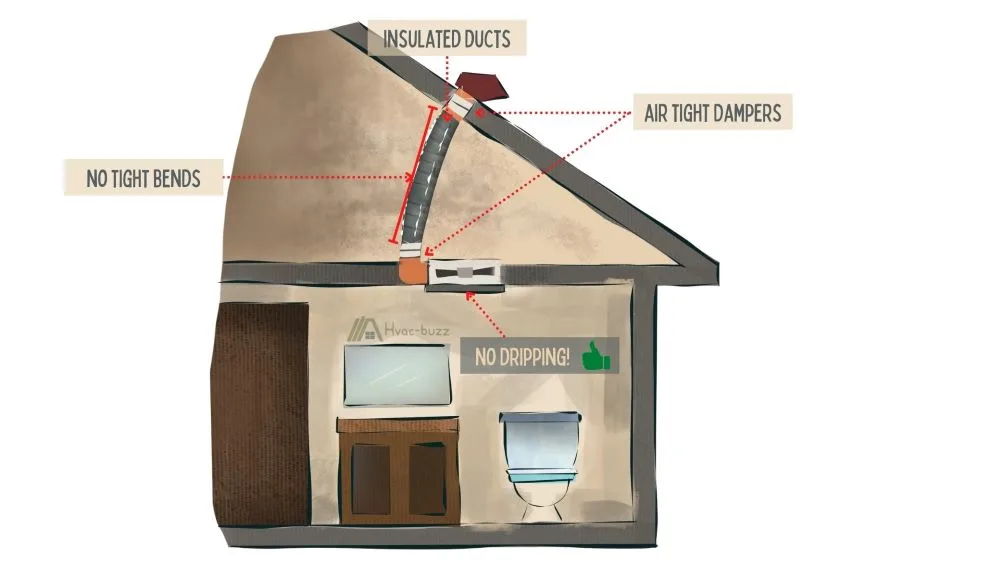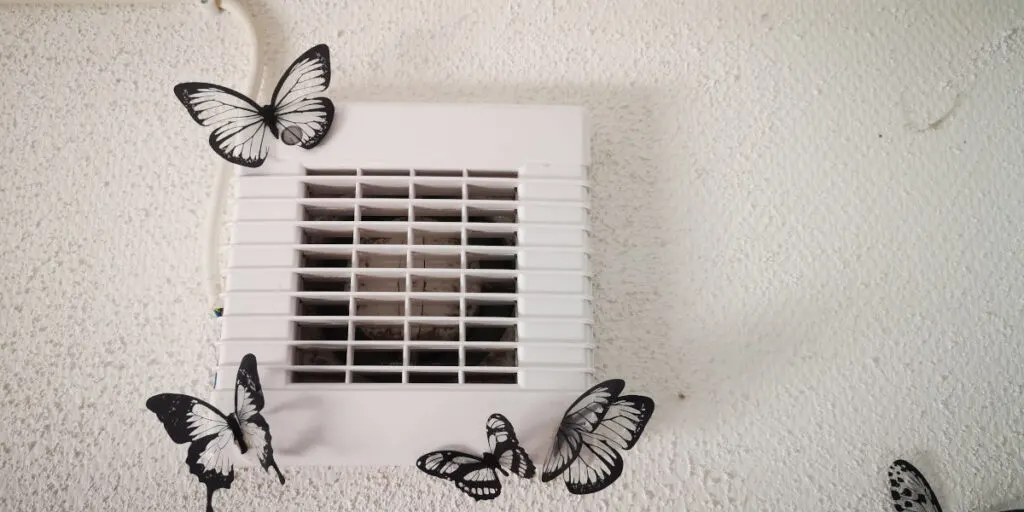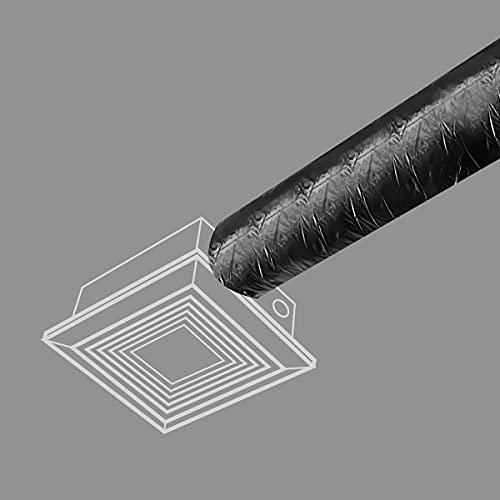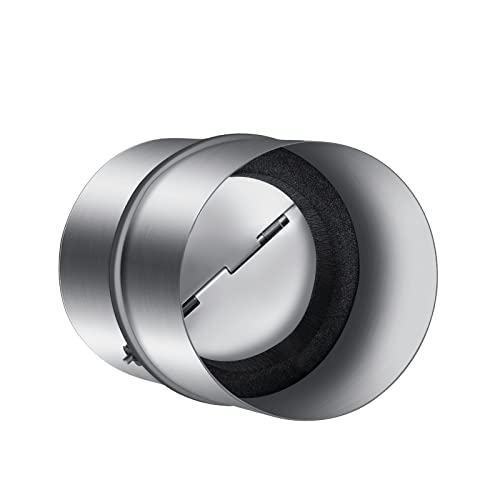Drip-drip-drop is no siren call and is honestly just a pain in the neck. Splashing through puddles is an activity that should be strictly limited to the outdoors. If you are looking to avoid this, you might be considering installing a condensation trap with your bathroom fan.
But it’s an extra cost of both money and time and begs the question: do you really need one? The only reason to install a condensation trap is if your fan will drip. Great, so how do you know that? Thankfully, you can take steps during installation that will help prevent dripping and, thus, the need for a trap.

The common reason bathroom fans drip is due to condensation forming in the ducts. A condensation trap is only necessary if the bathroom fan drips, and there are steps to take to help ensure it won’t: insulate the ductwork, use shorter ducting, use a good quality damper.
Condensation Traps Only Necessary if Fan Drips
If your fan does not drip, then a condensation trap is unnecessary. The problem is, how do you know if your fan will drip or not? And what happens if you don’t install the trap and the fan does drip?

The information in this article is aimed at helping you answer these questions and understand how to reduce the risk of dripping.
Problems With Dripping Fans
Dripping fans create several problems for a homeowner.
It ages your bathroom fan as it is exposed to dust and dirt that are caught in the water. Moreover, rust can form on the fan, and the dampness can also lead to mold and mildew growing in the ducts and around the fan and seals.

The water that forms on the floor can be a slipping hazard, especially for the oldest and youngest generations. So, it is very important not to have puddles standing in your bathroom for safety reasons.
Dirt and rust dripping into your bathroom will also cause staining. Dirty marks in your bathroom are unsightly and unwelcome, and as it is a recurring problem, your cleaning and repainting might feel futile after a while.
Mold and mildew are health hazards, and we all want to avoid them. Aside from the well-being of your household, mold and mildew can further compromise your bathroom fan if they grow on and damage the fan and seals in the ducting.
If your fan movement is compromised by building fungi, the condensation problem will worsen as air is exhausted less efficiently. The seals on your backdraft damper are necessary for airtightness in order to prevent the exhausted air from flowing back into the bathroom.
Why Do Bathroom Fans Drip?
Your bathroom fan might be dripping for a variety of reasons, the most common being due to condensation.
Condensation is the product of the meeting of air of different temperatures. This would cause your fan to drip.
The bathroom air is generally hot and humid after a shower, and the reason that the air is humid is because warmer air can hold more moisture than colder air. Condensation occurs when this hot air, in contact with colder air from outside, cools and can no longer hold as much water.
When the air cannot hold as much water, it forms droplets or condensation in the ducts, and this drips out of your bathroom fan.
This can also occur in tropical environments where the bathroom air is potentially the cooler party and the outside air is hot. The meeting will still produce condensation.
There are several reasons why condensation can form, and there are some pre-emptive actions you can take against the possibility.
Fans Less Likely to Need Condensation Trap If…
Dripping fans are common, but this doesn’t mean that they are normal.
I believe that a condensation trap is unnecessary if the duct is appropriately and properly insulated, is not excessively long, and if there is a quality, airtight damper installed in the duct.
Insulation
When you insulate the duct, you prevent the hot and cold air from meeting, which allows the extractor to exhaust the hot air from the bathroom. This, in turn, prevents condensation from forming, so your bathroom fan can stay dry and drip-free. This might even involve replacing old insulation that is no longer functioning appropriately.
Duct Length
Shorter ducts are more efficient because they can maintain the air pressure better. So, if your duct is shorter, it creates a more effective environment for the exhaust system to remove the air and moisture from the bathroom.
The more efficient your bathroom fan can be, the faster it can exhaust hot air, and this means there is less opportunity for condensation to form.
Damper
A backdraft damper is a necessary accessory for your bathroom fan, and a quality product with a good seal will help ensure your fan won’t drip. Backdraft dampers are designed to prevent the backflow of exhausted air.
With an airtight damper, hot air from the bathroom will be allowed into the ducts, but no air will be allowed to enter the bathroom via the same route. This prevents hot and cold air from mixing in your bathroom ducting, which allows the exhaust system to function effectively without condensation at the fan.
- An antidraft duct insert designed for use with range hoods, bathroom fans and other home HVAC applications.
- Features outer rubber gaskets that create an airtight seal and grip between the damper and ducts.
- Mounts horizontally or vertically to prevent backflow and debris from entering ducting.
- Galvanized steel body with spring-loaded aluminum damper blades that open with minimal airflow.
- Lightweight valve wings: The valve wings open under the pressure created by the airflow and then automatically close with the spring work. The backflow flap closes automatically at low air volumes....
- Keep away from rattling: It has an internal foam strip and a smooth-running spring to keep the valve wings from rattling. The position of the spring should be horizontal for horizontal installations...
- One-way airflow ducting insert: Back-flow valve with 2 spring-loaded wings prevents the reverse airflow movement through the ventilation duct when the ventilation system is turned off
- Material: The 4 inch Backdraft damper is made out of a Galvanized steel, the flap leaves are made of aluminum, while the Axis and spring are made of stainless steel and can withstand temperatures from...
Last update on 2024-03-27 / Affiliate links / Images from Amazon Product Advertising API
Can a Trap Be Added Later?
Ultimately, if you want to save on time and the expense of a condensation trap now and have problems in the future, you can just install it later. It is a relatively straightforward task if you want to do it yourself.
Make sure you follow the manufacturer’s directions!
A ducting condensation trap is installed on a vertical pipe between the fan and the termination point of the ducting. You should use a bathroom-appropriate caulk, preferably one that is anti-fungal such as Gorilla Silicone Sealant (amazon link).
Apply the caulk to the male fitting (the trap should be female) and then push the two components together. Once that has dried fully, you should apply an aluminum foil tape over the joints, like Nashua Multi-Purpose Foil Tape (amazon link) or Impresa Aluminum Foil Tape (amazon link).
Sources
https://www.cedengineering.com/userfiles/HVAC%20-%20How%20to%20Size%20and%20Design%20Ducts%20R1.pdf
https://hartmanbrothers.com/blog/difference-floor-vs-ceiling-heat-ducts
https://hvac-talk.com/vbb/threads/2200878-New-bathroom-vent-fan-dripping-water
https://www.networx.com/article/water-drips-from-bathroom-exhaust-fan




